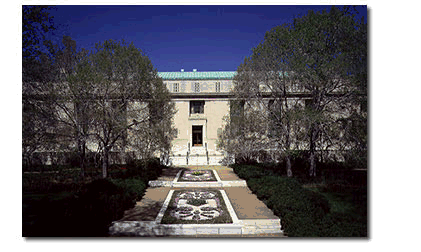« Measuring technological progress; a primer | Main | That "haha" kind of funny »
September 29, 2005
Networks in our nation's capital
 This past week, I attended the Statistics on Networks workshop at the National Academies of Science in Washington DC, where I saw many familiar faces and many new ones. In particular, I was very happy to finally meet Jon Kleinberg, John Doyle, Steve Borgatti and my collaborator Dimitris Achlioptas. And it was nice to see Walter Willinger and Chris Wiggins again, both of whom I met at the MSRI workshop on networks earlier this year. And naturally, it was nice to see my collaborator Mark Newman again, even though we correspond pretty regularly. Now that I've distributed the appropriate linkage for the search engines, let me get on with my thoughts.
This past week, I attended the Statistics on Networks workshop at the National Academies of Science in Washington DC, where I saw many familiar faces and many new ones. In particular, I was very happy to finally meet Jon Kleinberg, John Doyle, Steve Borgatti and my collaborator Dimitris Achlioptas. And it was nice to see Walter Willinger and Chris Wiggins again, both of whom I met at the MSRI workshop on networks earlier this year. And naturally, it was nice to see my collaborator Mark Newman again, even though we correspond pretty regularly. Now that I've distributed the appropriate linkage for the search engines, let me get on with my thoughts.
This workshop was interesting for a couple of reasons. First, the audience contained statisticians, social scientists, computer science/physics people, and engineers/biologists. Certainly the latter two groups presented very different perspectives on networks, with the former being interested in universality properties and random models of networks, while the latter was much more interested in building or decomposing a particular kind or instance of a network. The social scientists present (and there were many of them) seemed to have a nicely balanced perspective on the usefulness of random models, with perhaps a slight leaning toward the computer science/physics side. Naturally, this all made for interesting dinner and wrap-up discussion. For myself, my bias is naturally in the direction of appreciating models that incorporate randomness. However, it's true that when translated through a particular network model, randomness can itself generate structure (e.g., random graphs with power law degree distributions tend to have a densely connected core of high degree vertices, a structure that is a poor model for the core of the internet, where mixing is disassortative). In the case of real world networks, I think random models yield the most benefit when used to explore the space of viable solutions to a particular constraint or control problem. Eve Marder's work (also at the workshop) on small networks of self-regulating neurons (in this case, those of the lobster gut) is a particularly good example of this approach.
Second, although there were very few graduate students in attendance (I counted three, myself included), the environment was friendly, supportive and generally interesting. The workshop coordinators did a good job of inviting people doing interesting work, and I enjoyed just about all of the talks. Finally, it was interesting to see inside the National Academies a little. This institution is the one that fulfills the scientific inquiries of Congress, although I can't imagine this Congress listens to its scientists very much.
posted September 29, 2005 09:43 PM in Simply Academic | permalink